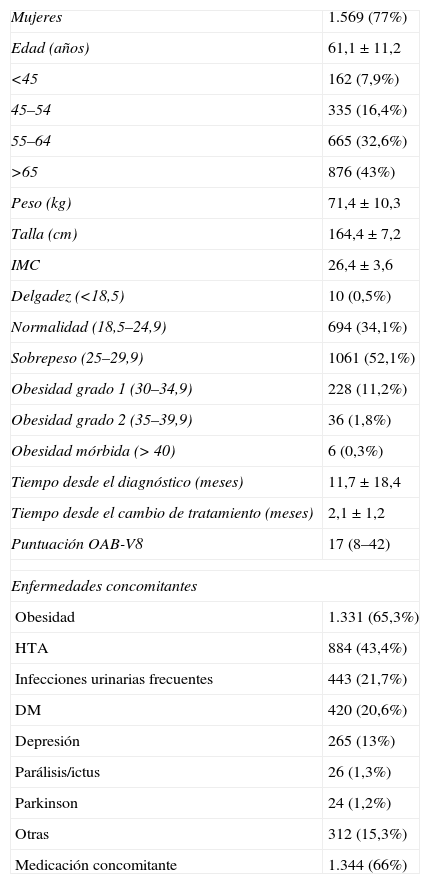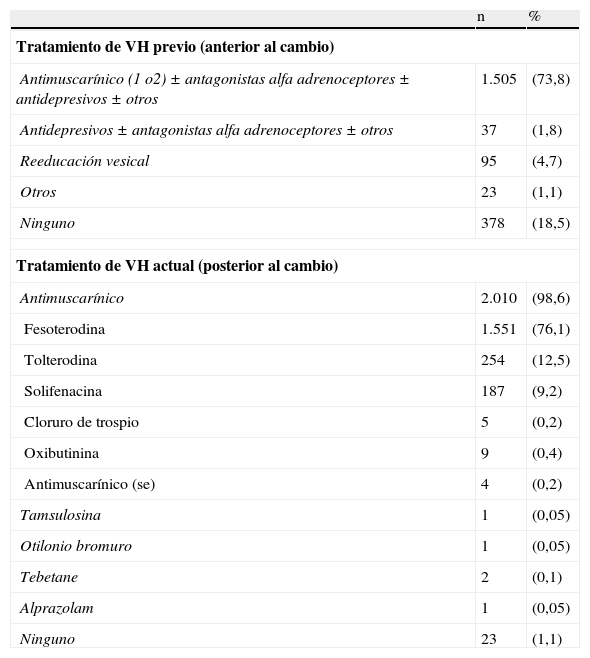aunque el tratamiento de la vejiga hiperactiva (VH) es eficaz, muchos pacientes no responden, por lo que interesa estudiar los motivos de cambio de tratamiento y la satisfacción del paciente con el nuevo tratamiento.
Material y métodosestudio epidemiológico, transversal, no intervencionista para determinar los motivos del cambio de tratamiento en VH y la satisfacción con dicho cambio. Se reclutaron pacientes con VH (OAB-V8 ≥ 8), de ambos sexos, mayores de 18 años, que habían modificado su tratamiento en los 3-4 meses previos. Se recogieron datos demográficos, síntomas, tratamiento previo, actual y concomitante, motivo del cambio, impresión clínica global (ICG) de gravedad y de mejoría, cuestionario Morinsky Green, satisfacción con el tratamiento, preferencia del mismo y la escala del beneficio del tratamiento (TBS).
Resultadosde 3.365 pacientes reclutados, 2.038 (61%) fueron evaluables (61,1±11,2 años; 77% mujeres). El médico solicitó el cambio de tratamiento en un 69% y el paciente en un 31% por motivos de falta de beneficio clínico (60%), efectos secundarios (24%), petición del paciente (8%), incumplimiento terapéutico (6%) y otros (2%). El 52% de los pacientes cumplió con el nuevo tratamiento. Según ICG, el 65,4% presentó mejoría respecto al tratamiento anterior. Un 60% de los pacientes se mostró bastante/muy satisfecho con el tratamiento actual, un 91% lo prefirió al previo y un 93% opinó que sus síntomas habían mejorado.
Conclusionesla falta de beneficio clínico es el principal motivo del cambio de tratamiento de la VH. La mayoría de los pacientes prefieren el nuevo tratamiento.
although efficacious, some patients do not respond optimally to overactive bladder (OAB) treatment. The objective of this study was to identify the reasons why some patients do not respond and to look for reasons for changes in treatment and patient satisfaction with the new treatment.
Materials and methodsepidemiological, cross-sectional, non-interventional study to determine the reasons for OAB treatment switching and satisfaction with such OAB treatment switch. OAB patients (OAB-V8≥8), 18 years or more, who had modified their treatment during the previous 3-4 months, were recruited. Demographic data, symptoms, previous, current and concomitant treatments, reasons for treatment switch, clinical global impression (CGI) on disease severity and symptom improvement, Morinsky Green questionnaire, satisfaction with treatment, treatment preference and treatment benefit scale (TBS) were compared.
Resultsout of 3,365 successive patients, 2,038 (61%) were eligible (61.1±11.2 years; 77% women). The physician decided to switch in 69% of the cases and 31% of patients asked for a change in treatment. Reasons for switching were lack of clinical benefit (60%), side effects (24%), patients’ request (8%), non-compliance (6%) and other (2%). 52% of patients complied with new treatment. According to the CGI, 65.4% showed improvement with respect to their previous treatment. 60% were quite/very satisfied with current treatment, 91% preferred it to their previous treatment and 93% reported that their symptoms had improved.
Conclusionsthe lack of clinical benefit is the main reason for changing OAB treatment. Most of the patients that switched prefer their new treatment.
Artículo
Comprando el artículo el PDF del mismo podrá ser descargado
Precio 19,34 €
Comprar ahora















